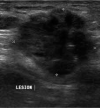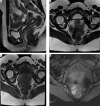Magnetic resonance imaging of endometriosis: a common but often hidden, missed, and misdiagnosed entity
- PMID: 36091649
- PMCID: PMC9453474
- DOI: 10.5114/pjr.2022.119032
Magnetic resonance imaging of endometriosis: a common but often hidden, missed, and misdiagnosed entity
Abstract
Endometriosis is a common benign and chronic inflammatory gynaecological disease due to functional endometrial glands and stroma in an ectopic location outside the uterine cavity. It affects 5-10% of reproductive age group women in the peak age of 24-29 years. However, women with infertility and chronic pelvic pain have an even greater prevalence, accounting for 30-50% and 90% of cases, respectively. Although it is a common entity, patients often get a delayed diagnosis because it is often subtle (hidden), missed, or confused with mimics, leading to misdiagnosis, which significantly affects patients' quality of life because they live in constant pain from undiagnosed endometriosis. Laparoscopy followed by histopathological confirmation is the gold standard for diagnosis, but it is an invasive procedure. MRI is an excellent non-invasive modality that helps in non-invasive diagnosis, with excellent delineation of the disease extent, and thus provides a presurgical mapping of the disease, which is helpful for the operating surgeon. Radiologists should be aware of all possible spectrum and diagnose this early and provide a detailed structured report mapping the entire extent of the disease process, which helps in effective treatment planning and successful outcomes in improving patients' quality of life.
Keywords: deep infiltrative endometriosis; endometrioma; endometriosis; malignant transformation; scar endometriosis.
© Pol J Radiol 2022.
Conflict of interest statement
The authors report no conflict of interest.
Figures












References
-
- Chamié LP, Blasbalg R, Pereira RM, et al. . Findings of pelvic endometriosis at transvaginal US, MR imaging, and laparoscopy. Radiographics 2011; 31: 77-100. - PubMed
-
- Woodward PJ, Sohaey R, Mezzetti TP Jr. Endometriosis: radiologic-pathologic correlation. Radiographics 2001; 21: 193-216. - PubMed
-
- Javiera AF, Cristian MS, Daniel GD, et al. . Endometriosis MRI: pictographic review. Rev Chil Radiol 2012; 18: 149-156.
-
- Chatman DL, Ward AB. Endometriosis in adolescents. J Reprod Health Med 1982; 27: 156-160. - PubMed
-
- Sangi-Haghpeykar H, Poindexter AN III. Epidemiology of endometriosis among parous women. Obstet Gynecol 1995; 85: 983-992. - PubMed
Publication types
LinkOut - more resources
Full Text Sources
